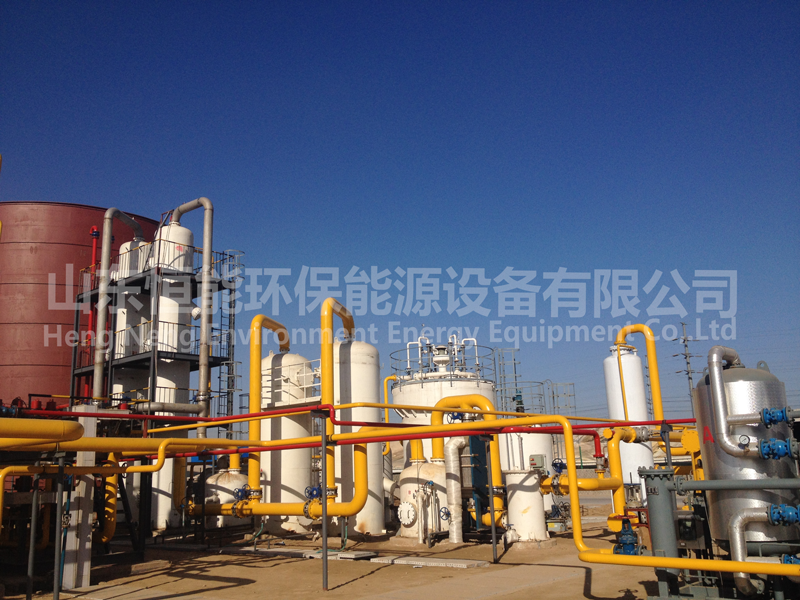在全球能源轉型的浪潮中���,清潔能源的開發與利用成為焦點。沼氣作為一種可再生能源����,其主要成分是甲烷,同時含有二氧化碳��、硫化氫等雜質。未經提純的沼氣因雜質影響�����,燃燒效率低、腐蝕性強��,限制了其大規模應用��。沼氣提純技術的出現�,猶如一把鑰匙����,解鎖了沼氣作為優質清潔能源的潛力,在能源領域掀起了一場綠色變革����。?
In the wave of global energy transition, the development and utilization of clean energy have become the focus. Biogas, as a renewable energy source, is mainly composed of methane and contains impurities such as carbon dioxide and hydrogen sulfide. Unprocessed biogas has low combustion efficiency and strong corrosiveness due to impurities, which limits its large-scale application. The emergence of biogas purification technology is like a key, unlocking the potential of biogas as a high-quality clean energy source and triggering a green revolution in the energy field. ?
沼氣成分剖析:復雜多元的氣體混合?
Analysis of Biogas Components: Complex and Multivariate Gas Mixtures
沼氣是有機物質在厭氧環境下�����,通過微生物發酵作用產生的一種可燃性氣體。其成分復雜多樣�����,甲烷(CH?)含量通常在 50% - 70% 之間��,是沼氣的主要可燃成分,決定了沼氣的能源價值。二氧化碳(CO?)含量約為 30% - 50%����,它的存在降低了沼氣中甲烷的濃度�����,進而影響沼氣的熱值。此外��,沼氣中還含有少量的硫化氫(H?S)�,其含量一般在幾百 ppm 到數千 ppm 不等。硫化氫具有腐蝕性和毒性���,不僅會腐蝕管道、設備���,還會在燃燒過程中產生二氧化硫等有害氣體,污染環境����。除了這些主要成分�����,沼氣中還可能含有少量的氮氣(N?)、氧氣(O?)、水蒸氣(H?O)以及一些揮發性有機化合物(VOCs)����。這些雜質的存在����,使得沼氣在直接使用時面臨諸多問題����,因此沼氣提純成為提升其品質和利用價值的關鍵步驟�����。?
Biogas is a combustible gas produced by microbial fermentation of organic matter in anaerobic environments. Its composition is complex and diverse, with methane (CH4) content typically ranging from 50% to 70%. It is the main combustible component of biogas and determines its energy value. The content of carbon dioxide (CO ?) is about 30% -50%, and its presence reduces the concentration of methane in biogas, thereby affecting the calorific value of biogas. In addition, biogas also contains a small amount of hydrogen sulfide (H ? S), whose content generally ranges from several hundred ppm to several thousand ppm. Hydrogen sulfide is corrosive and toxic, not only corroding pipelines and equipment, but also producing harmful gases such as sulfur dioxide during combustion, polluting the environment. In addition to these main components, biogas may also contain small amounts of nitrogen (N ?), oxygen (O ?), water vapor (H ? O), and some volatile organic compounds (VOCs). The presence of these impurities poses many problems for the direct use of biogas, making biogas purification a key step in improving its quality and utilization value. ?
提純原理:針對性去除雜質提升品質?
Purification principle: Targeted removal of impurities to improve quality
沼氣提純的核心原理是利用不同氣體在物理或化學性質上的差異���,有針對性地去除沼氣中的雜質��,提高甲烷濃度。對于二氧化碳的去除,主要基于其與甲烷在溶解性�����、吸附性等方面的不同��。在物理吸收法中��,利用二氧化碳在特定溶劑中的溶解度大于甲烷的特性,通過將沼氣通入吸收塔�,使二氧化碳溶解在溶劑中����,從而實現與甲烷的分離。例如,采用甲醇作為吸收劑��,在低溫高壓條件下�����,二氧化碳能大量溶解于甲醇��,而甲烷則幾乎不溶。在化學吸收法中,利用二氧化碳與某些化學試劑發生化學反應的性質來實現分離����。如采用醇胺類溶液�����,二氧化碳會與醇胺發生可逆反應�����,生成氨基甲酸鹽��,從而從沼氣中被脫除。?
The core principle of biogas purification is to use the differences in physical or chemical properties of different gases to selectively remove impurities from biogas and increase methane concentration. The removal of carbon dioxide is mainly based on its differences in solubility, adsorption, and other aspects compared to methane. In the physical absorption method, the solubility of carbon dioxide in a specific solvent is greater than that of methane. By introducing biogas into an absorption tower, carbon dioxide is dissolved in the solvent, thereby achieving separation from methane. For example, using methanol as an absorbent, carbon dioxide can dissolve significantly in methanol under low temperature and high pressure conditions, while methane is almost insoluble. In the chemical absorption method, separation is achieved by utilizing the property of carbon dioxide reacting chemically with certain chemical reagents. If an alcohol amine solution is used, carbon dioxide will undergo a reversible reaction with the alcohol amine to generate amino formate, which will be removed from biogas. ?
硫化氫的去除則主要利用其還原性和酸性�����。在干法脫硫中����,常用的脫硫劑如氧化鐵,硫化氫與氧化鐵發生化學反應��,生成硫化鐵和水���,從而將硫化氫從沼氣中去除��。在濕法脫硫中�����,利用堿性溶液與硫化氫發生中和反應,或者利用強氧化劑將硫化氫氧化為單質硫��,實現脫硫目的�����。對于水蒸氣,由于其在低溫下容易凝結�����,通過冷卻沼氣��,使水蒸氣冷凝成液態水����,從而從沼氣中分離出去�。對于其他雜質,如氮氣�����、氧氣和揮發性有機化合物等�,可根據其物理化學性質,采用吸附�����、膜分離等技術進行去除����,最終得到高純度的甲烷氣體。
The removal of hydrogen sulfide mainly relies on its reducibility and acidity. In dry desulfurization, commonly used desulfurizers such as iron oxide and hydrogen sulfide react chemically with iron oxide to produce iron sulfide and water, thereby removing hydrogen sulfide from biogas. In wet desulfurization, alkaline solution is used to neutralize hydrogen sulfide, or strong oxidizing agents are used to oxidize hydrogen sulfide into elemental sulfur, achieving the purpose of desulfurization. For water vapor, due to its tendency to condense at low temperatures, cooling biogas can condense it into liquid water, thereby separating it from biogas. For other impurities such as nitrogen, oxygen, and volatile organic compounds, adsorption, membrane separation, and other techniques can be used to remove them based on their physical and chemical properties, ultimately obtaining high-purity methane gas.
This article is a friendly contribution from biogas purification For more information, please click on: Sincere Attitude To provide you with comprehensive services We will gradually contribute more relevant knowledge to everyone Coming soon.
